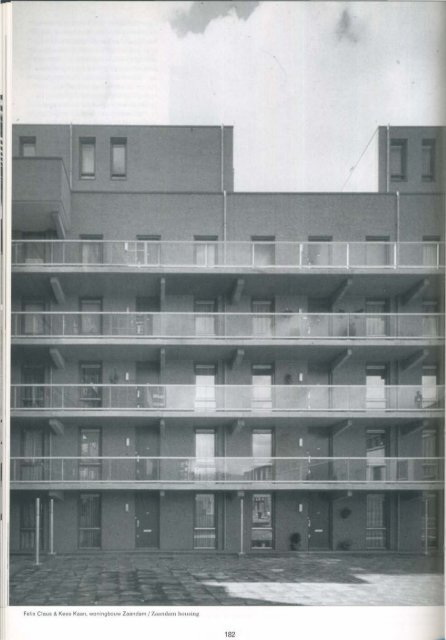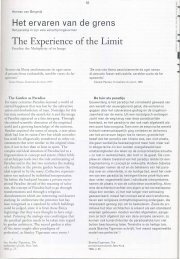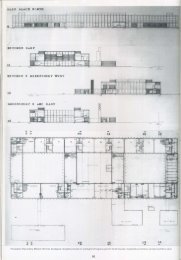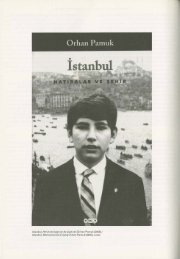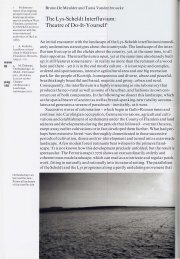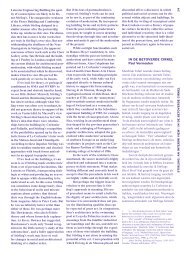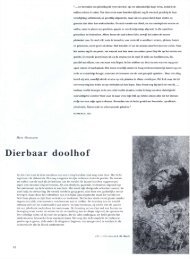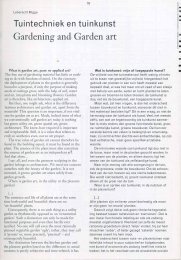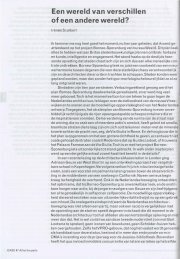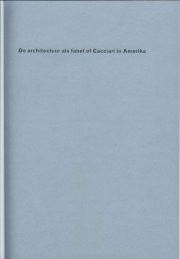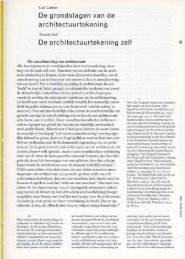OASE_49-50_182.pdf - OASE Journal for Architecture
OASE_49-50_182.pdf - OASE Journal for Architecture
OASE_49-50_182.pdf - OASE Journal for Architecture
Create successful ePaper yourself
Turn your PDF publications into a flip-book with our unique Google optimized e-Paper software.
Epilogue<br />
A conventional building at Zaandam andfive<br />
rhetoric questions to Felix Claus and Kees Kaan<br />
A long time has passed since the winter evening when<br />
a delegation of editors of Oase met Felix Claus and Kees<br />
Kaan at their Amsterdam office. The lively conversation<br />
continued into the late night and offered a remarkable<br />
glimpse behind the screens. The two architects had taken<br />
lhe initiative to organise a series of lectures at the<br />
Amsterdam Academy of <strong>Architecture</strong> titled 'Thicker than<br />
paper' <strong>for</strong> which they had asked architects from various<br />
European countries to talk about their design approach<br />
and the built projects.<br />
<strong>Architecture</strong> thicker than paper, buildings that owe<br />
U1eir strength to an economical use of architectural<br />
gestures, not overtly designed <strong>for</strong> swift consumption.<br />
Soon tile conversation turned to the opportunities and<br />
limitations which the context of building in Holland<br />
imposes on such an approach. By way of illustration<br />
Felix Claus and Kees Kaan discussed one of their then<br />
most recent projects.<br />
The design <strong>for</strong> a large apartment building at<br />
Zaandam, a smallish commuter town north of<br />
Amsterdam, had undergone major changes in the<br />
montils previous to the conversation, be<strong>for</strong>e in an<br />
ultimate attempt at further cutting the costs the design<br />
acquired its definitive <strong>for</strong>m. This development was<br />
remarkable not so much <strong>for</strong> the relentless simplification<br />
produced by tile cuts but <strong>for</strong> the sense of relief which the<br />
architects expressed about it - a liberation which seems<br />
to have affected their work ever since.<br />
Simple volumes and an unequivocal expression of<br />
weight, seriality and anonymity have not been prime<br />
characteristics of postwar Dutch architecture. The tradi<br />
tion of denying weight and a conception of architecture<br />
as assemblage or a composition of abstract planes was<br />
trangely confronted (and possibly confirmed) by Hans<br />
Kallhoff's notorious Piraeus building in Amsterdam, but<br />
continues to exist in an endless array of <strong>for</strong>ms and<br />
emanations.<br />
Paradoxically, it is in the very country which has<br />
achieved a level of standardisation in the building indus<br />
try which is unparallelled in Europe that architects try<br />
their utter best to avoid the standard. The industrial char<br />
acter of tile building process comes disguised by rhetoric<br />
gestures and an inventive application of material. Under<br />
no circumstances is the solution allowed to be self<br />
evident; perhaps, because in these provinces famed <strong>for</strong><br />
their low budgets a building must not be too sober, too<br />
poor, too commonplace; and most certainly not unsenti<br />
mentally hard?<br />
Instead of tile quiet calm which can be achieved<br />
through tile mastery of ordinary <strong>for</strong>ms of construction,<br />
there are often fussy details which communicate noth-<br />
Mechthild Stuhlmacher & Christoph Grafe<br />
183<br />
Epiloog<br />
Een conventioneel gebouw in Zaandam en vijf<br />
retorische vragen aan Felix Claus en Kees Kaan<br />
Het is al geruime tijd geleden. Op een winterse avond ont<br />
moetten enkele Oase-redacteuren Felix Claus en Kees Kaan<br />
op hun bureau in Amsterdam. Het geanimeerde gesprek<br />
duurde tot diep in de nacht en bood een opmerkelijke blik<br />
achter de schermen. Aanleiding voor de afspraak was de<br />
lezingenreeks die de beide architecten aan de Academie<br />
voor Bouwkunst in Amsterdam hadden georganiseerd.<br />
Onder de titel 'T hicker than paper' hadden ze architecten<br />
uit verschillende Europese Ianden uitgenodigd om over<br />
hun standpunten te praten en hun werk te Iaten zien.<br />
Architectuur dikker dan papier, gebouwen die hun<br />
betekenis ontlenen aan een spaarzaam gebruik van<br />
architectonische middelen, niet ontworpen voor de snelle<br />
consumptie. AI snel kwam het gesprek ook op de<br />
mogelijkheden maar ook de beperkingen die het bouwen in<br />
Nederland aan zo'n houding oplegt. Ter verduidelijking hier<br />
van lieten Felix Claus en Kees Kaan een van hun recente<br />
projecten zien.<br />
Het antwerp voor een groot woongebouw in Zaandam<br />
had in de aan het gesprek vooraf gaande maanden al een<br />
groot aantal veranderingen moeten ondergaan, voordat de<br />
laatste- in vele gevallen dodelijke- bezuinigingsronde de<br />
vorm bepaalde die uiteindelijk gebouwd zou worden. Het<br />
opmerkelijke hieraan waren niet de onbarmhartige vereen<br />
voudigingen door de bezuinigingen, maar het gevoel van<br />
bevrijding dat deze kaalslag bij de architecten teweeg had<br />
gebracht- en zeker ook hun latere ontwerpen heeft<br />
be"lnvloed.<br />
Eenvoudige bouwmassa's en een onverholen expressie<br />
van zwaarte, seriematigheid en anonimiteit zijn ontwerp<br />
aspecten die niet of nauwelijks in het repertoire van de<br />
recente Nederlandse architectuur voorkomen. De traditie<br />
van gewichtloosheid en het denken in vlakken in plaats van<br />
in massa's werd weliswaar door het controversiele gebouw<br />
'Piraeus' van Hans Kallhoff in Amsterdam op een merk<br />
waardige manier met zichzelf geconfronteerd (misschien<br />
zelfs bevestigd), maar leeft onverminderd en in oneindig<br />
veel vormen en gedaanten voort.<br />
In het land met de me est gestandaardiseerde bouw<br />
industrie in Europa doen architecten hun uiterste best om<br />
de standaard te ontwijken. Het industriele karakter van het<br />
bouwproces wordt verhuld in retorische gebaren of inventief<br />
materiaalgebruik. De oplossing mag niet voor de hand<br />
liggen. Misschien omdat in het land met de laagste bouw<br />
prijzen een gebouw vooral niet te sober, te arm, te gewoon<br />
mag zijn? En zeker niet te onsentimenteel hard?<br />
In plaats van de vanzelfsprekende kalmte die uit de<br />
beheersing van het gangbare kan voortkomen, zien we<br />
opgedirkte 'details', die niets vertellen- niet over hoe het<br />
gebouw gemaakt is, niet over hoe het zich verhoudt tot zijn<br />
fysieke en mentale context, niet over de normen en<br />
<strong>OASE</strong> # <strong>49</strong>/<strong>50</strong> 1998
ing; not Lhe process of making the building, not how it<br />
relates to a physical or mental context, not the standards<br />
and agreements which make building in Holland into a<br />
relatively smooth affair.<br />
Again t this background, the expression of an<br />
unbroken volume and the bloody-minded repetition of<br />
industrial products displayed in Claus and Kaan's project<br />
are a truly notable achievement. Instead of indulging in<br />
architectural expressionism in order to conceal the<br />
happy banality of the programme - a safe, healthy <strong>for</strong>m<br />
of living somewhere in Holland - there is a quiet,<br />
calming appearance of the same, unmodified elements<br />
throughout the building. In the preliminary sketches the<br />
brief which originally included a variety of types and<br />
categories of dwellings was used to divide the volume<br />
into smaller entities expressed on the outside. Later,<br />
the fa
swift consumption. There is hardly any time to develop the<br />
ease and ordinariness which characterises the anonymous or<br />
industrial buildings which are often in the architect's mind.<br />
'<strong>Architecture</strong> thicker than paper' would have to find a balance<br />
between <strong>for</strong>m and rejection of <strong>for</strong>m, standard and exception,<br />
order and tolerance, between the desire <strong>for</strong> innovation and<br />
engaging with the conventional and traditional. The lecture<br />
series was organised to develop these ideas further. One of the<br />
speakers was the London-based architect Adam Caruso: 'It is<br />
doubtful whether completely new <strong>for</strong>ms can exist. The imper<br />
ative assigned to the radically new - that such <strong>for</strong>ms have no<br />
connection to the past and are the harbinger of an enhanced<br />
future- is tautological, and fundamentally conservative. A<br />
more radical <strong>for</strong>mal strategy is one that considers and repre<br />
sents the existing and the known. In this way artistic produc<br />
lion can critically engage with an existing situation and<br />
contribute to an ongoing and progressive cultural discourse?<br />
This statement summarises some of the concerns dis<br />
cussed in the current issue of Oase. The work of Felix Claus<br />
and Kee Kaan addressess the same strategies which Adam<br />
Caruso refers to. However, a number of questions remain<br />
unanswered; questions about the nature and significance of<br />
'conventional architecture':<br />
1. Convention I commonplace<br />
and observation<br />
The collection of texts, articles and<br />
van de behoefte naar vernieuwing en het doorontwikkelen<br />
van het bestaande. 'Thicker than paper' werd georgani<br />
seerd om hierover verder na te denken. Onder andere werd<br />
de Londense architect Adam Caruso uitgenodigd als<br />
gastspreker: 'Het is onwaarschijnlijk dat volkomen nieuwe<br />
vormen daadwerkelijk bestaan. De verwachting die men aan<br />
het zogenaamd radicaal nieuwe stelt- dat zulke vormen<br />
geen verbinding hebben met het verleden en een voorteken<br />
zijn voor een zich duidelijk manifesterende toekomst-<br />
is tautologisch en principieel conservatief. Een <strong>for</strong>mele<br />
strategie die uiteindelijk veel radicaler is, is een strategie,<br />
die het bestaande en bekende juist wei overweegt en repre<br />
senteert. Op die manier kan de productie van een kunst<br />
werk kritisch op een bestaande situatie reageren en zo bij<br />
dragen aan een zich steeds vernieuwend cultureel debat.'<br />
Deze stelling vat een aantal ontwerpaspecten samen,<br />
die in de verschillende bijdragen van dit nummer zijn verza<br />
meld. Felix Claus en Kees Kaan hebben met hun inmiddels<br />
vrij omvangrijke oeuvre de door Adam Caruso bedoelde<br />
strategieen aan de orde gesteld en hiermee ook steeds<br />
weer vragen opgeroepen. Vragen over het belang en de<br />
betekenis van conventie:<br />
projects starts with the perception of the<br />
photographer's consciously directed view<br />
through the camera. In photography the<br />
precision of perception can be addressed<br />
directly. Photography is able to put<br />
<strong>for</strong>ward banal and trivial things, the well<br />
known and the too-well-known and lhere<br />
<strong>for</strong>e unnoticed. Choosing the subjects, the<br />
photographer pays special attention to<br />
them, expecting or even demanding the<br />
same from the viewer, <strong>for</strong>cing the viewer<br />
to rearrange and re<strong>for</strong>mulate the percep<br />
tion. A photographer exposes the subject<br />
by showing it. <strong>Architecture</strong> potentially has<br />
the means to evoke a similar attentiveness<br />
as well. If we talk about common things,<br />
we mean, in the first place, unconsciously<br />
perceived daily objects and images; in<br />
architectural terms: building elements<br />
like the (bay) window, the door, the stair<br />
to the door, the rooflight etc. In the daily<br />
use and the daily experience of cities,<br />
there are all these small things that attach<br />
a space, a building or a street to our<br />
memories.<br />
Claus & Kahn use the term observa<br />
tion to develop the strategies they talk<br />
about. How can observation of everyday<br />
185<br />
1. Conventie I gemeenplaats en<br />
waarneming<br />
Wij beginnen deze verzameling teksten en<br />
projecten in Oase met de bewust gerichte<br />
blik van de fotograaf door zijn camera.<br />
In de fotografie kan de precisie van de<br />
waarneming zonder omwegen aan de orde<br />
worden gesteld, de fotograaf kan onopge<br />
merkte, misschien bekende, banale of<br />
triviale dingen naar voren halen, onder de<br />
aandacht brengen en ervoor zorgen dat<br />
men er opnieuw en met andere ogen naar<br />
kijkt. Een fotograaf plaatst zijn onderwer<br />
pen in een nieuw Iicht, door ze te Iaten<br />
zien. Als architect heeft men hiervoor eve<br />
neens middelen in handen. Als wij het over<br />
het 'bekende' hebben, zijn dat in eerste<br />
instantie onopvallende, alledaagse dingen,<br />
bijvoorbeeld van bouwelementen zeals het<br />
raam, de erker, de deur, het trapje naar de<br />
deur, de dakkapel enzovoort. In het<br />
dagelijkse gebruik en de beleving van de<br />
stad zijn het vaak ongelooflijk kleine<br />
dingen, die- al dan niet onopgemerkt- een<br />
bouwwerk, een ruimte, een straat enzovoort<br />
in het onbewuste geheugen doen<br />
verankeren.<br />
Observatie is een begrip dat jullie<br />
graag gebruiken, observatie en strategie.<br />
Hoe kan de architectuur observerend te<br />
werk gaan, en welke veranderingen<br />
<strong>OASE</strong> # <strong>49</strong>/<strong>50</strong> 1998
experiences influence architecture, and<br />
what kind of changes are involved in this<br />
process of observation when it becomes<br />
part of an architectural language?<br />
2. Convention I abstraction and<br />
rearrangement<br />
1\vo years ago you explained to us the<br />
different stages of the design process of a<br />
large housing project in Zaandam, a<br />
process which started with a building<br />
apparently assembled out of several cubic<br />
volumes, expressing their varied<br />
programme quite literally. As the brief<br />
became simplified this expression subse<br />
quently changed to an elegant volume<br />
with a carefully layered facade wrapping<br />
around the building, producing a rich<br />
transitory zone from inside to outside. The<br />
final result, however, is a building expos<br />
ing its 'naked' <strong>for</strong>m; all the architectural<br />
ingredients required to produce a<br />
multi-layered, 'pleasant' image had been<br />
stripped off. The appearance is simplified<br />
to its ultimate point. The bare <strong>for</strong>m, con<br />
sisting of an extremely reduced number of<br />
element , there<strong>for</strong>e acquires an almost<br />
inappropriate significance - but still<br />
needs to meet all the emotional, aesthetic<br />
and functional requirements without the<br />
support of auxiliary elements. The win<br />
dow is reduced to a hole, the cheap brick<br />
is presented as such without any kind of<br />
softening colour or texture, the expected<br />
'friendliness' of a house <strong>for</strong> living seems<br />
to be superseded by the architectural<br />
statement.<br />
How does this design attitude relate to<br />
its function and to the context, which in<br />
this case, has changed from an industrial<br />
environment to a residential area partly<br />
redefined by the new building itself?<br />
5. Convention I neutrality and<br />
nostalgia<br />
The collection of articles in this issue of<br />
Oase bears the subtitle 'a search <strong>for</strong> the<br />
general language of architecture'. Many of<br />
your projects seem to express a (nostal<br />
gic?) longing <strong>for</strong> a lost balance of general<br />
consensus and individual self-expression,<br />
a longing <strong>for</strong> the neutrality of an architec<br />
ture that dissolves into the urban fabric,<br />
without losing its individual character.<br />
Neutrality as a style and thus as part of<br />
the quickly changing architectural fash<br />
ions is an important concern of many<br />
'younger' European architects. Through<br />
widespread publication even this style has
187<br />
ondergaan banale voorwerpen, relaties,<br />
verhoudingen, elementen enzovoort als zij<br />
onderdeel worden van een architectonische<br />
taal?<br />
2. Conventie I abstractie en<br />
vervreemding<br />
Twee jaar geleden hebben jullie ons aan<br />
de hand van het project in Zaandam de<br />
verschillende stadia van het ontwerpproces<br />
toegelicht- een proces, dat began met<br />
een bouwblok, dat uit verschillende,<br />
kubische volumes leek te bestaan, zich dan<br />
ontwikkelde tot een zwierig blok met een<br />
gelaagde gevel random en rijke over<br />
gangszones van binnen en buiten en uitein<br />
delijk resulteerde in een van aile moderne<br />
ingredienten ontdane 'naakte' vorm van een<br />
woongebouw. De geminimaliseerde<br />
vormentaal van jullie studentenhuisvesting<br />
in Zwolle suggereert een vergelijkbaar<br />
ontwerpproces. Tot in het extreme vereen<br />
voudigd in zijn uiterlijke verschijning krijgt<br />
datgene wat er dan over is een belang, wat<br />
het anders nooit zou hebben -en moet in<br />
zijn ruwe uitgekleedheid aan aile gebruiks<br />
wensen en esthetische verlangens zonder<br />
'hulpmiddelen' voldoen. Het raam is een<br />
gat, een goedkope steen ligt op een onwen<br />
nig presenteerplaatje, de 'vriendelijkheid'<br />
is opgegeven voor een statement.<br />
Hoe verhoudt zich deze ontwerphouding<br />
tot het programma en de context, die in dit<br />
geval van een gebied dat beheerst werd<br />
door industriele productie veranderd is in<br />
een woongebieden gedeeltelijk<br />
geherdefinieerd wordt door het nieuwe<br />
gebouw?<br />
3. Conventie I neutraliteit en<br />
nostalgie<br />
Dit themanummer van Oase over conventie<br />
heeft als onuitgesproken ondertitel 'de<br />
zoektocht naar de algemene taal van de<br />
architectuur'. Of een dergelijke taal en<br />
consensus daadwerkelijk hebben bestaan,<br />
verandert niets aan het feit dat uit een<br />
aantal van jullie ontwerpen een enigszins<br />
nostalgisch verlangen naar het verloren<br />
evenwicht spreekt, een balans tussen indi<br />
viduele expressie en het neutrale opgaan<br />
in het stedelijk weefsel. Met neutraliteit als<br />
een stijl en dus als iets, wat aan de snel<br />
veranderende architectuurmodes onderhe<br />
vig is, houden zich op dit moment in Europa<br />
een groat aantal jonge architecten bezig.<br />
Via een vloed van snel op elkaar volgende<br />
publicaties ontstaat een zekere competitie<br />
binnen deze stijl- hoewel men zich door<br />
<strong>OASE</strong> # <strong>49</strong>/<strong>50</strong> 1998
ecome competitive - although it was<br />
meant to overcome the necessity of style<br />
and <strong>for</strong>m. You mention a project by the<br />
Austrian office Riegler & Riewe which is<br />
very similar to the south elevation of your<br />
project on the Kadijk in Amsterdam, down<br />
to the details of the hinges of the French<br />
balcony doors. How would you react to<br />
this? And what does the term 'style' mean<br />
to you in this respect?<br />
4. Convention I history and<br />
reduction<br />
Traditional art history conceived the<br />
development of architecture as an<br />
oscillating movement between Baroque<br />
and Classical periods. Usually it is hard to<br />
accept a position within these movements<br />
<strong>for</strong> oneself- it feels like reducing the<br />
importance of one's work to a temporary<br />
one. Your buildings obviously express the<br />
search <strong>for</strong> a timeless quality of architec<br />
ture. You try to achieve this timelessness<br />
by stripping drastically all additions and<br />
rhetoric gestures from your designs.<br />
This process of reduction, however, is<br />
inevitably a limited one. Reduction cannot<br />
do the work on its own.<br />
How would you view your position<br />
within the apparently inescapable cyclical<br />
repetition of architectural movements?<br />
5. Convention I context and<br />
continuity<br />
The two projects addressing urban<br />
continuity quite explicitly are small infill<br />
projects in the centre of Amsterdam, the<br />
Binnen Wieringerstraat and the Kadijk<br />
project. Both projects are additions to a<br />
traditional urban context, communicating<br />
with the neighbouring buildings, the<br />
wider context, the common character of<br />
programme and typology. How is this kind<br />
of contextual approach and dialogue with<br />
the site affected when - like <strong>for</strong> instance<br />
at Zaandam - the building has to create<br />
and define its own context?<br />
In an article on the work of Claus<br />
and Kaan (De Architect, ovember 1997)<br />
Dirk van de Heuvel writes: 'The<br />
individual exists only within the social,<br />
an vice versa the social can emerge only<br />
from interactions between individuals;<br />
innovation gains its significance by<br />
engaging with the tradition and traditions<br />
can only remain valid if they allow<br />
constant renewal!<br />
188
189<br />
deze stijl juist van de dwang tot stijl of<br />
vorm wilde bevrijden. Jullie geven zelf aan,<br />
dat er bijvoorbeeld een nieuw project van<br />
Riegler & Riewe in Graz bestaat, dat<br />
sprekend op de noordgevel van jullie<br />
Kadijk-woningen lijkt, tot en met het<br />
scharnierdetail van de Franse balkon<br />
deuren. Hoe reageren jullie hierop?<br />
En, wat is de rol van het begrip stijl?<br />
4. Conventie I geschiedenis en<br />
reductie<br />
De kunstgeschiedenis wordt vaak gezien<br />
als een wederkerige, langzame golfbewe<br />
ging, tussen barokke en klassieke perioden.<br />
Het is vaak moeilijk zichzelf als deel van<br />
zulke tijdafhankelijke stromingen te begrij<br />
pen- het lijkt het belang van datgene<br />
waarmee men bezig is, te reduceren. Het<br />
zoeken naar tijdloosheid is een streven, dat<br />
veel van jullie gebouwen kenmerkt. Deze<br />
tijdloosheid zoeken jullie te bereiken door<br />
jullie projecten van aile retorische gebaren<br />
en toevoegingen te ontdoen. En toch is het<br />
duidelijk, dat reductie een eindig proces is.<br />
Reductie kan dus niet aileen 'het werk<br />
doen'. Hoe zien jullie jullie werk in dit per<br />
spectief van de onontkoombaar lijkende<br />
cyclische herhaling van de (architectuur)<br />
geschiedenis?<br />
5. Conventie I context en<br />
continu'iteit<br />
De twee projecten, waar continu'lteit en<br />
stedelijke context expliciet aan de orde<br />
komen, zijn de kleine projecten aan de<br />
Binnen Wieringerstraat en op de Kadijken<br />
in Amsterdam. Seide projecten vormen een<br />
toevoeging aan de 'hele', intacte context<br />
van de oude Amterdamse binnenstad en<br />
nemen op een heel precieze manier contact<br />
op met hun buren, de wijdere omgeving,<br />
met programma en typologie. Wat gebeurt<br />
echter met de noodzaak van contextualiteit<br />
en een dergelijk rijke dialoog met de plek<br />
en de geschiedenis bij andersoortige<br />
opdrachten, wanneer een intacte context in<br />
die zin ontbreekt of door het nieuwe object<br />
zelf moet worden geschapen?<br />
Dirk van den Heuvel heeft in zijn artikel<br />
over het werk van Claus en Kaan in De<br />
Architect van november 1997 geschreven:<br />
'het individuele bestaat aileen binnen het<br />
sociale, en omgekeerd kan het sociale<br />
aileen bestaan uit de interacties tussen<br />
individuen; vernieuwing kan aileen<br />
plaatsvinden binnen een doorwerken aan<br />
tradities, en omgekeerd houden deze<br />
tradities aileen hun geldigheid, als zij zich<br />
voortdurend Iaten vernieuwen'.<br />
<strong>OASE</strong> # <strong>49</strong>/<strong>50</strong> 1998


